Menu
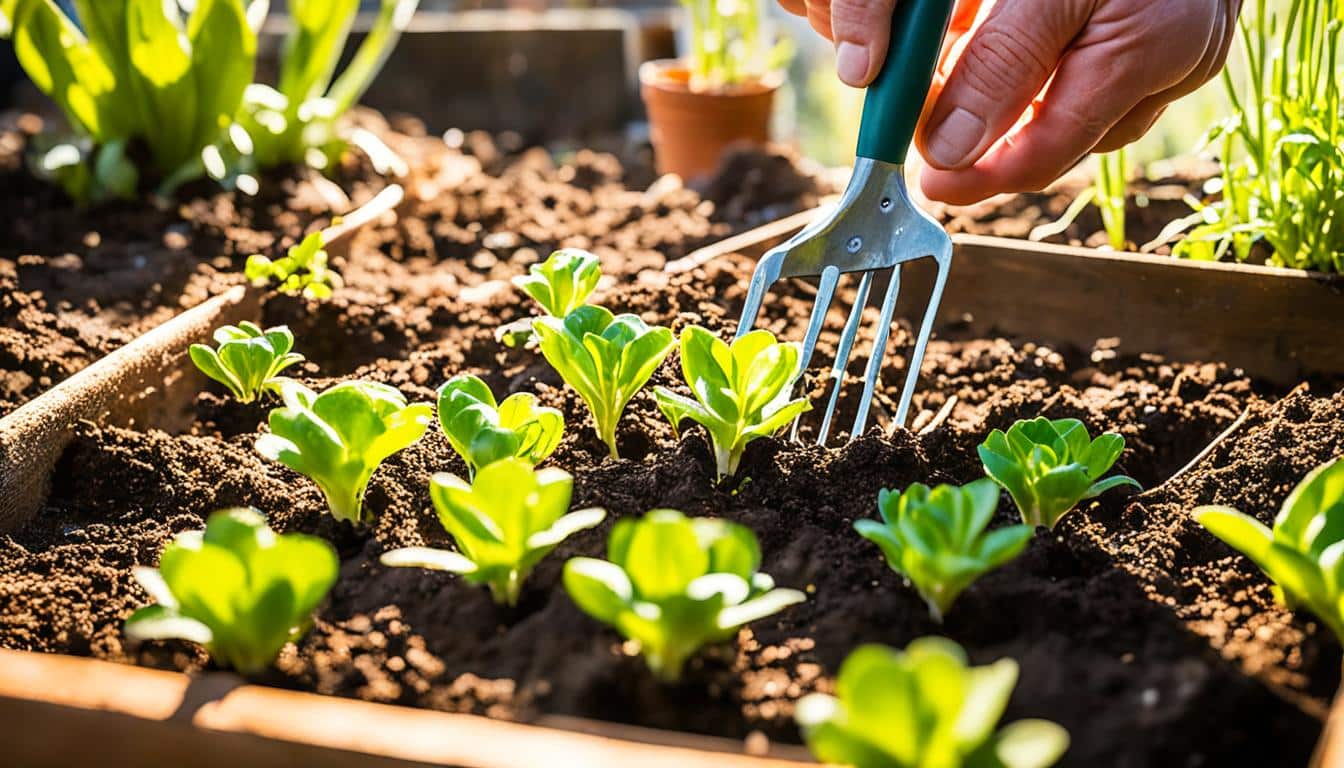
Did you know just watering lawns once a week can save a lot of water? This tip helps keep your garden green and healthy. Spring is the right time to revive your garden. Some key steps will make sure your garden looks great all summer.
Preparing the soil, smart planting, and keeping an eye on pests are vital. Also, trim back your plants, watch for diseases, and control pests. These efforts add up to a beautiful garden. Enjoy the longer sunny days by looking after your garden. Fix any winter damage and plan your garden design. This will make a big difference in your garden’s health and look.
After winter, it’s key to check your garden’s health. Winter often brings tough challenges. This includes trees and shrubs breaking from heavy storms. For example, in Milton, MA, two big red oak trees snapped at the bottom due to severe weather. The impact of March’s nor’easters hurt trees and plants more.
Looking closely at your garden helps spot what’s broken. Check at all levels, from tree tops to the ground. Perennials might need a trim, and you should examine paved areas too. Not watering plants enough in winter makes them grow slowly or get winter burn. A good soak can help them recover.
Many forget about meadow voles in garden upkeep. These critters burrow and eat plant roots. Frost heaving can also push plants out of the ground, making recovery harder.
When planting, consider your zone’s hardiness rating, which shows a plant’s ability to survive the local climate. But remember, winter can be unpredictable. Sometimes, even severely damaged plants can grow back.
Too much fertiliser can make damaged plants sicker. B1 vitamins don’t necessarily help them recover. Keep the plants fit by cutting off dead or sick parts.
Watch how you plant based on what damage you see. For example, think about where plants are and if pots might be safer. Look for signs like different plant colours to understand their health. Changes in budding can show you how they’ve weathered the winter.
Test plant health by looking under their bark and checking stem strength. In a cold snap, many plants in Nashville, TN, didn’t make it.
The harm isn’t just to a few types of plants. Distylium shrubs in Zone 7 are browning and losing leaves. Azaleas in the Encore series don’t show much life. Hollies like the inkberry holly are losing leaves fast, showing big damage.
Spring is here, and getting your soil ready is key to a healthy garden. It’s vital to prep the soil for planting. This includes testing pH, adding organic matter, and making sure the soil is aerated well. These steps lead to healthier plants and a better harvest.
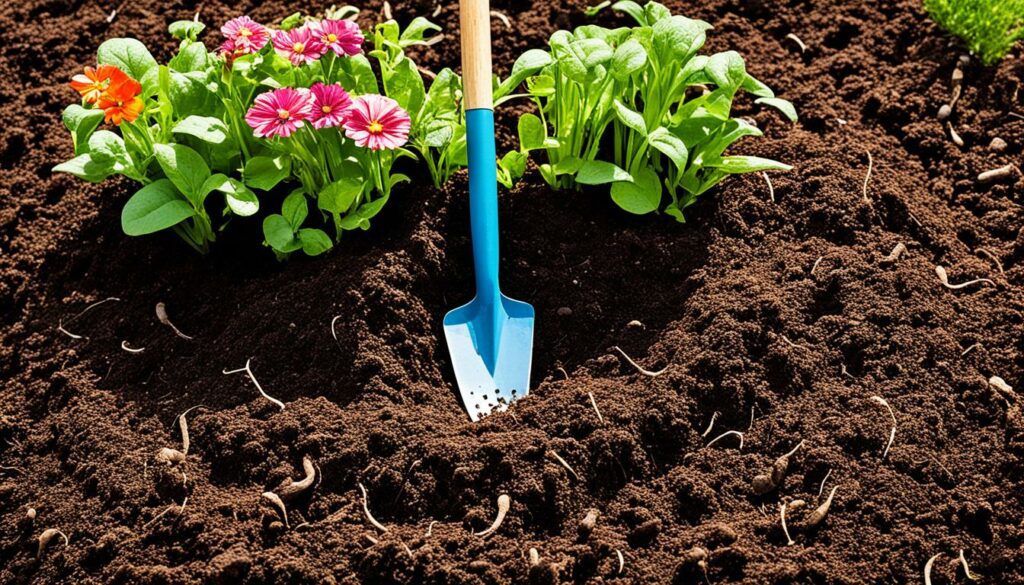
The first thing to do is check your soil’s pH. Most garden plants like a pH of 6.0 to 7.0. You can get your soil tested by places like Penn State or the University of Massachusetts. They can test for nutrients and heavy metals. After the test, you might need to add garden lime or powdered sulphur to adjust the pH. Be aware, changing the soil’s pH can take a year to have full effect.
Adding organic matter is key for good soil. Mix 30% topsoil with 70% compost for new gardens. Compost improves the soil’s nutrients and helps good bugs thrive. Putting compost on your garden each year keeps these benefits coming. Also, using aged manure, leaf mould, and coconut coir makes the soil rich and fertile.
The soil type in your garden affects what it needs. Loamy soil, a mix of sand, silt, and clay, is great for growing. It holds water well but drains, too. Clay soil needs to be mixed with compost for better drainage. If your soil is sandy, it lacks nutrients. Add compost and manure to boost its fertility.
Getting your soil ready with the correct steps is crucial for a great garden. Testing the pH and adding organic matter are key, ensuring your plants grow well.
Clearing garden debris is key for good gardening. It keeps your outdoor space healthy. Experts say you should wait until it’s consistently about 50 degrees Fahrenheit during the day for a week. This helps protect insects like bees and butterflies. These insects spend winter in leaf piles or under the ground.
When it’s warmer, get to work raking leaves and clearing old plant parts. This stops mould and keeps pests away from new plants. Remove last year’s annual flowers too, so there’s space for new ones. This keeps your garden looking bright all year.
Pruning needs some thought. It’s best to prune summer flowers on 50-degree days. This helps them grow well. It also helps not to cut plants if you see chrysalises or cocoons on them. Let’s these insects grow naturally.
Getting beds ready for planting is important too. Remove weeds and add compost or manure. This feeds the soil for new plants. Paying attention to how you plant and using a planting guide can really help your garden.
To finish, give the lawn some air. Aerating and seeding helps grass grow strong. Using tools like augers can make this easier. Then, add mulch when the soil is warm. This keeps moisture in and the soil the right temperature for plants.
Following these steps really helps your garden. It lets you plant correctly and at the right time. This makes your garden a great place to be.
Pruning is vital when following a seasonal planting guide, especially in spring. It’s key for healthy plant growth and makes your garden look better. By cutting out dead or sick branches and pruning at the right time, plants can get a real boost.
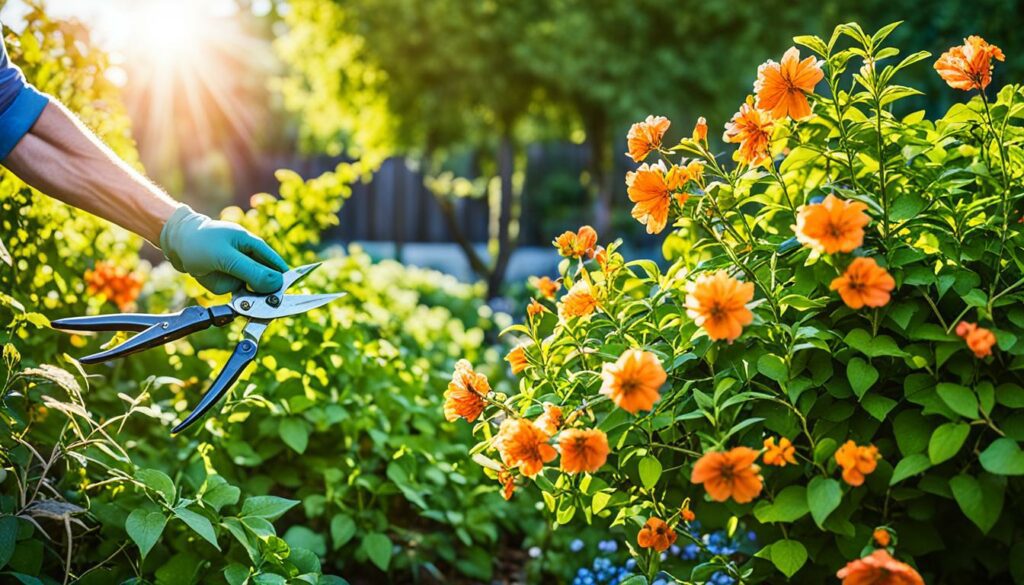
Start by snipping off dead or sick branches to help your plants stay healthy. This step lets more light in and improves air flow, cutting down on disease risk. It’s advised by gardening experts to cut off any unhealthy parts to stop sickness spreading.
Picking the right time to prune is critical for plant health and good fruit. Early spring pruning can be done by thinning out half of the fruit set. This can lead to larger and better fruit. For example, peaches and other fruits can be thinned down to one every six inches.
It’s best to prune before plants bloom, usually when the buds are starting to open. This way, it’s clearer which fruits should be kept. Following these steps based on the plant’s needs and your local climate matters a lot.
For trees and shrubs that bloom in spring, prune them after June 15th, when they’re done flowering. Pruning keeps your plants in good shape and looking nice. It helps them stay the right size and maintain their beauty.
Fertilising your garden right is key to a strong and healthy space. By picking the best fertiliser and how you apply it, your plants will grow well. Organic types are great for the earth and they last a long time.
Organic fertilisers come from natural stuff like plants and animals. They help keep your garden healthy and in balance. When you choose one, look at the N-P-K numbers. These tell you how much nitrogen, phosphorus, and potassium are in it. For example, tomatoes do better with a 3-4-6 kind that has extra calcium. This stops a disease called blossom-end rot. Even if they cost a bit more at first, organic fertilisers are better for the planet and your garden in the long run.
| Vegetable | Recommended N-P-K Ratio | Additional Notes |
|---|---|---|
| General Vegetables | 3-4-4 | Balance of essential nutrients for a variety of vegetables. |
| Tomatoes | 3-4-6 | Includes calcium to prevent blossom-end rot. |
| Sweet Corn | 3-4-4 | Beneficial at different growth stages; apply when 8-10 inches tall and after tasseling. |
Knowing how to put fertiliser on is as important as choosing the right kind. Mix granular stuff into the top soil or water it to get to the roots. Liquid types go in the water that you use to water the plants. Different plants need different amounts, so it’s important to know your plants well. Too much fertiliser can actually harm your plants.
Using organic fertiliser makes your garden strong and helps the environment. Make sure to follow the right schedule for each plant. This will make your garden lush and fill it with lots of fruits and vegetables.
Spring is a great time to try different planting techniques. The changing weather and longer days mean it’s key to boost your plants’ growth. Knowing what different plants need is vital for a thriving garden.
Start with seeds that need a long time to grow, like tomatoes. This gets your plants growing early and makes their roots strong. Moving them from inside to outside needs special care. You must help them adjust to the outdoor climate slowly.
Find out about your area’s agricultural zone. Different zones are best for certain plants to do well.
Right after you move your plants outside is a critical time. Using mulch in late winter helps keep your plants safe and stops weeds. It’s also smart to check your soil’s pH and add the right fertilisers. This makes the soil just right for your plants.
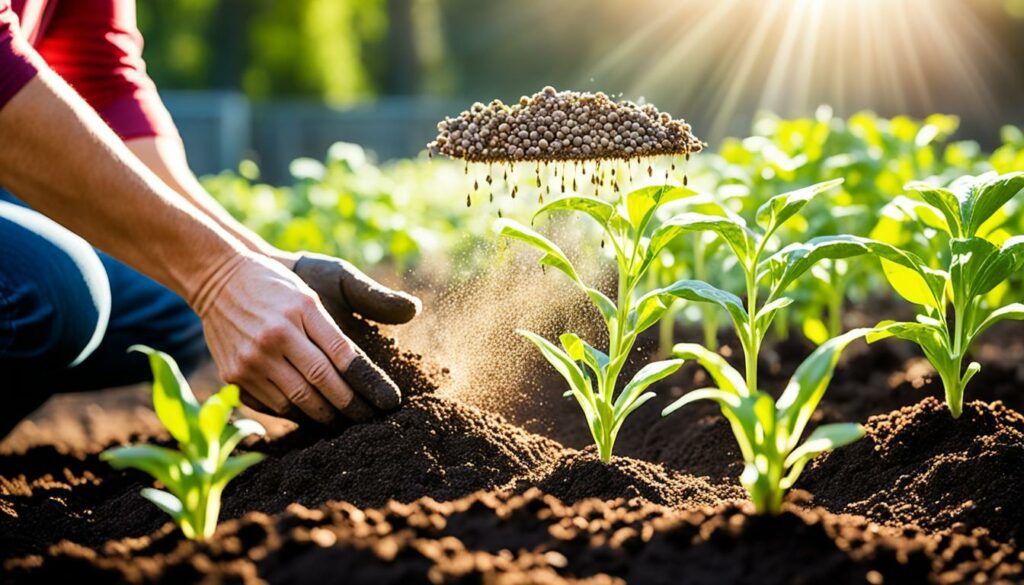
| Planting Technique | Benefit |
|---|---|
| Starting Indoors | Gets plants growing early in places with shorter growing times. |
| Hardening Off | Helps plants get used to the outside without getting shocked, which helps them live. |
| Mulching | Stops weeds and keeps soil wet, helping plants grow. |
| Soil pH Testing | Makes sure your plants can use the soil’s nutrients well, keeping them healthy. |
By using proper planting techniques, you make a big change in how well your garden grows and what it produces.
Growing plants indoors from seeds gives your garden an early boost. This way, your veggies, herbs, and flowers will be bigger and better. They’ll also bloom or produce food for longer.
Some plants do well when you seed them indoors. Lettuce, broccoli, and more can be planted in February. Arugula, kale, and onions are perfect for January. Basil, cucumbers, and others do best when planted in April. Picking the right start time can really help your garden.
It’s crucial to take good care of your seedlings. They need plenty of light, 12-16 hours daily. Use LED lights or T5 fluorescents for the best growth. Keep the lights close, 2-3 inches away, and move them up as plants grow.
Using a heat mat can help seeds sprout faster and stop fungi. It gives your plants a strong start. Misting the soil keeps it moist but not too wet, which is key for seedlings.
Watering carefully is vital. A watering can with a rain nozzle or watering from below is best. Apply a water-based fertiliser or fish emulsion after two true leaves show for good plant food.
It’s also good to keep your plants labelled. This makes it easy to know what’s who later on. Plant seeds at the right depth. Follow this gardening advice to get your plants ready for the great outdoors. This will help your garden flourish.
Moving seedlings to your garden is key for their growth. You need to get them used to the outdoors and pick the right time.
Hardening off your seedlings is important. This means slowly introducing them to outside conditions. It helps them get used to the weather and decreases the shock of moving.
Start by placing them outside for a short while, then increase it daily. They become stronger and can cope with different weather.
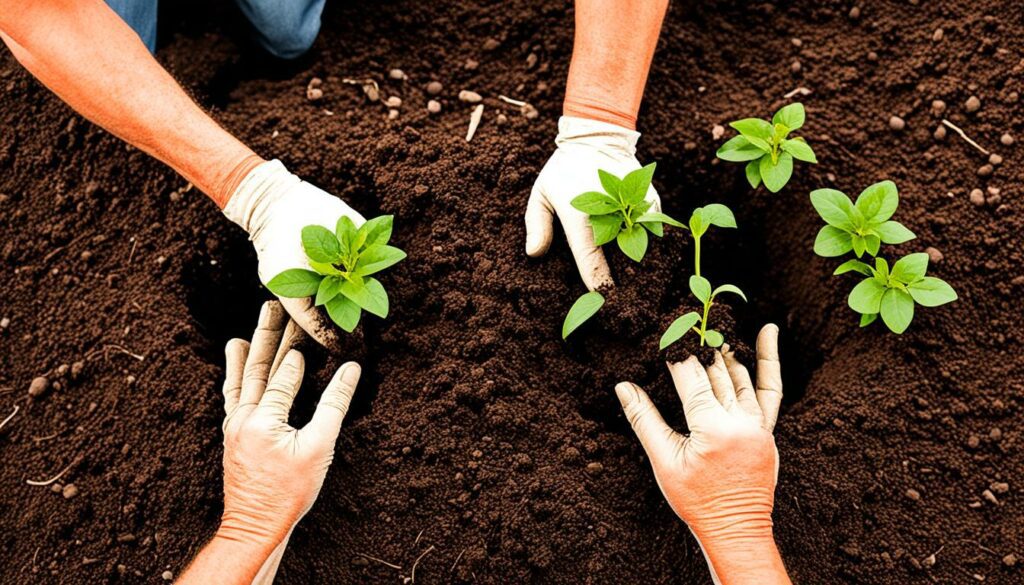
When you move your plants is very important. Check the weather and frost dates first. Wait to move heat-loving plants like tomatoes until nights are 60°F (15°C) or warmer.
If you’re planting cool-weather crops like spinach, do it early. Make sure the soil isn’t too wet or dry. Watering the area deeply the day before helps.
It’s also good to have paths in your garden. This keeps the soil from getting too packed. It helps your plants get the water and air they need.
Don’t forget to protect your plants from spring frosts. Use cloches, cold frames, or covers. This will help them get strong outside.
| Plant Type | Transplant Timing | Optimal Conditions |
|---|---|---|
| Tomatoes | Nighttime temps above 60°F (15°C) | Frost-free period |
| Spinach | Before outdoor temps rise | Cool-season, early spring |
By following these steps, your plants will do well. Your garden will be full of healthy, productive plants if you take care of them properly.
Mulching is key to a flourishing garden, following the seasonal planting guide. It helps keep the garden healthy and beautiful. Mulch keeps moisture in the soil, helps regulate temperature, and feeds the plants the nutrients they need.
Using organic mulch is great for your garden. It breaks down, adding important nutrients to the soil. This supports plant growth. Organic mulch also keeps the soil moist, which is crucial in hot weather. Plus, it stops soil from washing away and makes your garden look tidy.
For the best outdoor planting, choose organic options like leaf mould, well-rotted horse manure, and homemade compost.
Choosing the right mulching method is essential. A layer of mulch 2 to 2.5 inches thick works well. It helps with weed control, keeps the moisture in, and protects roots. But, putting on too much mulch can cause problems like too much water which harms the roots.
Keep mulch from touching tree trunks. This avoids harm to the tree. Mid to late spring is a good time to mulch, after the winter cold is gone. But, you should check with local experts for the best timing in your area.
Both organic and inorganic mulches have their benefits. Organic mulches add nutrients as they break down. Inorganic mulches, like rocks, are good for stopping weeds but don’t feed the soil. Choose the right mulch for what your garden needs. With good mulching, your garden will thrive, meeting the advice of any good seasonal planting guide.
Good watering methods are key to planting success. They greatly help plant health and growth. Outdoor planting benefits a lot from good watering. Deep waterings less often are best. They make roots strong, helping plants be tough and healthy.
Water your plants in the morning or evening. This cuts down on water lost to the air. Using a watering wand or drip system gets water to the roots. It is also important to keep soil moisture even. But let it dry out slightly between waterings to help roots grow.

Flower beds do better with fewer but big waterings. Try to water them once or twice a week. Late evening or early morning waterings avoid too much water evaporating. This way, plants absorb more of the water they need.
It’s vital to keep plant leaves dry to stop diseases. Make sure water really reaches the roots. Doing this helps the whole plant, from roots to flowers. Watering evenly around each plant helps its root system grow everywhere.
Automatic watering systems with soil moisture checks save water. A thin layer of mulch also helps soil keep its moisture. Good soil should be rich in clay. This type of soil holds onto water and stops it from collecting too much, especially when it’s already wet.
| Rules for Watering | Description |
|---|---|
| Morning Watering | Best time for maximum absorption, minimal evaporation. |
| Even Moisture | Promotes healthy root growth with slight drying intervals. |
| One to Two Sessions Weekly | Better than frequent small waterings for deep irrigation. |
| Dry Leaves | Avoid diseases by keeping leaves dry during watering. |
| Deep Watering | Ensures water reaches roots, supports plant structures. |
| Proper Distribution | Water around the plant evenly to prevent one-sided roots. |
| Efficient Irrigation | Use automatic systems with moisture sensors to save water. |
| Avoid Waterlogging | Prevents suppression of root oxygen intake. |
| Thin Mulching | Allows moisture to reach roots, prevents blockage. |
| Clay-rich Soil | Holds water efficiently, avoids waterlogging. |
Use these tips and tricks to water your garden well in spring. Your plants will show how good care brings great results.
To keep your garden healthy and colourful, you need to stay alert and use smart planting methods. Check your plants often to catch problems early and stop them from spreading.
It’s best to use natural ways to control pests. Most insects are either harmless or good for your plants. Keeping a balance is key. You can use barriers, traps, and friendly bugs to protect your garden. This approach is safer for the environment than using chemicals.
| Practice | Benefit |
|---|---|
| Crop Rotation | Reduces insect damage and soilborne diseases |
| Planting Resistant Varieties | Offers natural resistance to pests and diseases |
| Good Plant Care | Reduces stress and susceptibility to pests |
| Sanitation Practices | Prevents the spread of pathogens |
| Checking Plants Regularly | Prevents severe outbreaks |
Changing where you plant your crops every few years helps keep the soil healthy. Look for seeds labelled as disease-resistant to cut down on plant problems.
Taking good care of your plants makes them stronger. Put natural materials around them and keep the weeds away. Remember, cleaning your hands and tools stops sickness from spreading.
If plants are in bad shape, bugs might bother them more. Some insects really love vegetables and can cause a lot of harm. In addition to bugs, other pests and diseases can ruin your garden.
Letting your garden rest over winter sometimes can lessen next year’s troubles. Picking off big bugs by hand is a powerful and eco-friendly way to protect your plants. It works about 85% of the time.
Many good bugs, like ladybirds and mantises, help keep pests in check. Moving your crops around yearly can stop soil diseases from becoming too common. Planting certain flowers can push away harmful insects with great success.
Spring is a great time to put new plants and shrubs in your garden. It makes your garden look nicer and healthier. Plants and shrubs add to the beauty and life of your garden.
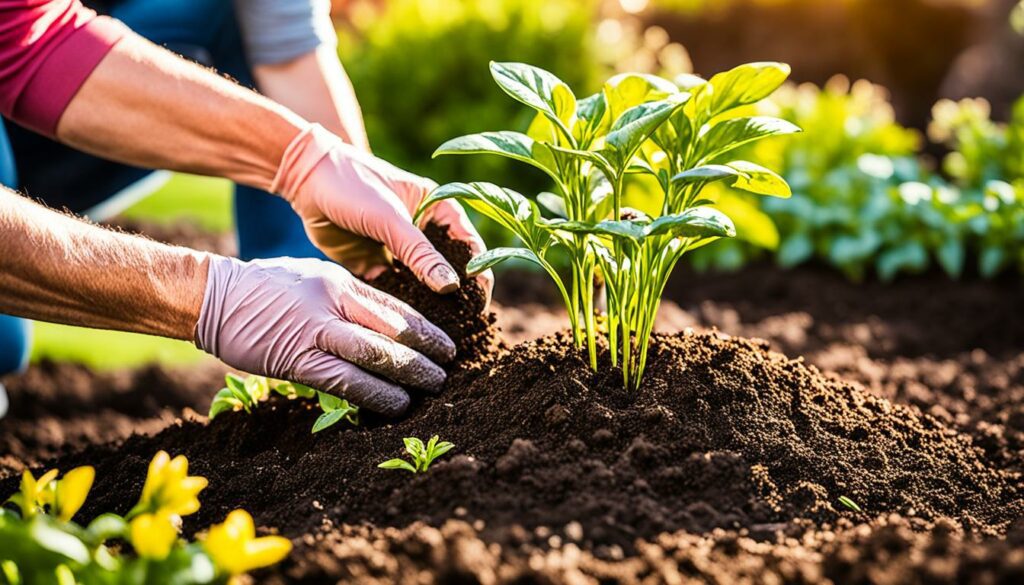
It’s important to pick plants that match your local weather and garden setup. Make sure they get the right amount of sunlight. Some plants need lots of sun, some need a bit less, while others can grow in the shade. Knowing this makes your garden easier to look after and helps the plants grow well.
Early spring is ideal for planting bare-root types when it’s cooler. This lets the plant’s roots grow well before summer. In Atlanta, people have found that watering new plants daily for the first two weeks is key. It helps them settle in better.
Testing soil by filling a hole with water can show if it drains poorly. If water stands after two hours, it’s not good. You can make the soil drain better and keep it moist by using special hoses and timers. This keeps plants well watered which is critical for their growth.
A layer of shredded bark mulch, 2-3 inches deep, is also good. It keeps the soil moist and the temperature stable. This prevents weeds and makes your garden care less of a challenge. The first year, focus on helping the roots grow. After that, your plants will grow and bloom more, making your garden livelier.
To keep your garden green all the time, you need to care for it often. Water your plants regularly, especially during their growing time. Usually, a lawn needs about an inch of water every week or 20 minutes’ worth of water three times weekly. The exact amount can differ, depending on your lawn’s needs and your area’s rain.
Looking after your garden also means watching out for pests and diseases. Check your plants often and deal with any problems you find quickly. Healthy plants start with the right fertiliser – use something like 6-6-6 or 8-8-8 when they start growing again. Removing dead or sick branches helps plants grow better and flower more.
To keep soil good, weed regularly and add mulch. Mulch not only makes your garden look nice but also keeps the soil moist and helps stop weeds. And, splitting your perennials before they grow in the spring can help them and new plants do well.
Maintaining bird feeders is also really important. Clean them every week with a mild bleach solution for hygiene, and keep them filled with fresh food. It’s also key to keep birdbaths and feeders clean all year. Birds in the garden not only look and sound nice but also help your garden’s ecosystem.
Following a plan for caring for your plants makes them not only live but also thrive. Gardening can also make you feel good, reducing anxiety and depression by 30%. It’s a great way to keep fit too, burning 200 to 400 calories every hour you spend out there.
So, keeping your garden healthy is good for both your plants and yourself. By sticking to a schedule and giving your garden lots of love, you’ll have a beautiful, sustainable outdoor area.
Starting a compost pile is key to managing a garden well. It helps the environment and makes the soil better. By using the right mix of items, you can turn trash into nutrients for the earth.
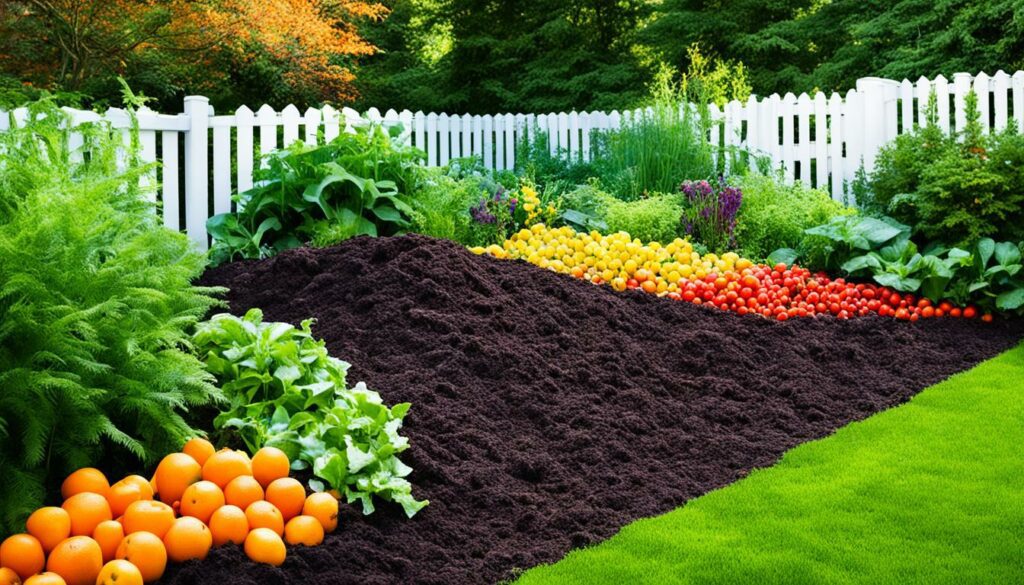
To make compost fast, mix green and brown items. You should use more brown than green, about twice as much. Green things, like food scraps and grass, add nitrogen. Brown items, such as dry leaves and cardboard, provide carbon. This mix creates good compost.
You need to turn the compost often to let air in. This keeps it warm and breaks down materials quickly. Also, make sure the compost is damp but not soggy. It should feel like a sponge that’s been well squeezed.
“Compost can be ready in a few months to a year. But, with care, you can make it faster.” – Advice from gardening experts.
There are fast ways to make compost, like using an electric composter, which takes just three hours. Or, you can go the traditional route, which might take a few months to a year, depending on how well you look after it and the weather.
Shredding organic matter, keeping the compost moist, and using red wigglers can speed up composting. Red wigglers, especially, are great for turning food scraps into compost indoors.
Starting a compost pile lets you recycle food and garden waste. It helps save money and the planet. These tips are important for a green garden.
Putting ready compost on the soil before planting helps plants grow better. These gardening tips will guide you to a compost pile that supports a healthy garden and is good for the planet.
Spring changes a lot for gardeners. Using a good planting guide and the right techniques matters a lot. Different areas in the United States have different climates. A successful garden starts by checking any winter damage and adding organic matter to the soil. This helps make the soil better for plants and bugs that plants need.
Mulching is key in early spring. It keeps the soil at the right temperature, keeps moisture in, and stops weeds. In cold areas, start planting lettuce, spinach, and radishes early. This gives them a good start before it gets too warm. If your area might get late frosts, it’s wise to start some plants inside. And water your plants often, especially if you live in a dry place.
Early pruning helps air flow in your garden and stops some problems. Be careful not to give too much fertilizer, but the right amount helps plants grow early on. Check for pests often and treat them quickly to keep your garden healthy. Fix any empty lawn spots by spreading seeds and fertilizer. Spring’s warmth and longer days mark the start of the growing season. This is good for plants and for gardeners, who feel better with all the activity. By doing these things, your garden can look great and be eco-friendly.
Look at every garden level to find what needs fixing. Check tree branches for any dangers. Cut back perennials and see if you need to fix any tools. Prepare to tidy up and get ready for new plants.
Prepping the soil means your plants can grow strong. Test the soil’s pH and add organic matter. This helps plants grow well. It also lets air and water move freely in the soil, which is good for tiny organisms and worms.
It’s important to get rid of old leaves and branches. This stops mould and bugs that can make plants sick. A clean garden also makes it easier to do other tasks like preparing the soil.
Start by cutting off any dead or sick branches. This improves how much light and air gets to other branches. When you prune is important, especially for some plants that do best if you cut them after they’ve flowered. This keeps them healthy and looking good.
Choose slow-release organic fertiliser for healthy plants. Adding compost and mulch also helps the soil. This means you might not need to use as much chemical fertiliser.
Start seeds early, like tomatoes, indoors. Take care when you move them outside. They should get used to the outdoor weather first. This stops them from getting shocked when they move.
Tomatoes and peppers do well if you start them off inside. Make sure they get enough light and water. This helps them grow well and not get shocked when you move them outdoors.
Get your plants used to outdoor weather first, which is called hardening off. Then, choose the best time to plant them in soil that’s ready. They’ll need plenty of water and support.
Mulch keeps the soil moist, cool, and full of nutrients. Put it around plants, but not touching their stems. This keeps your garden healthy.
Water deeply but less often so roots grow deep and strong. Early mornings are best for watering, as plants can take in more water.
Check your garden often and use natural ways to stop bugs and diseases. This keeps the garden healthy without harming helpful insects.
Choose plants that like the weather where you live. Plant them on cooler, darker days. This helps them settle in well.
Keep watering, pruning, and looking after pests and weeds. Change your care with the seasons to keep your garden beautiful and healthy all year.
Make a compost pile from plant scraps for great soil. Use a mix of ‘brown’ and ‘green’ materials. Turn the pile often to make compost faster.